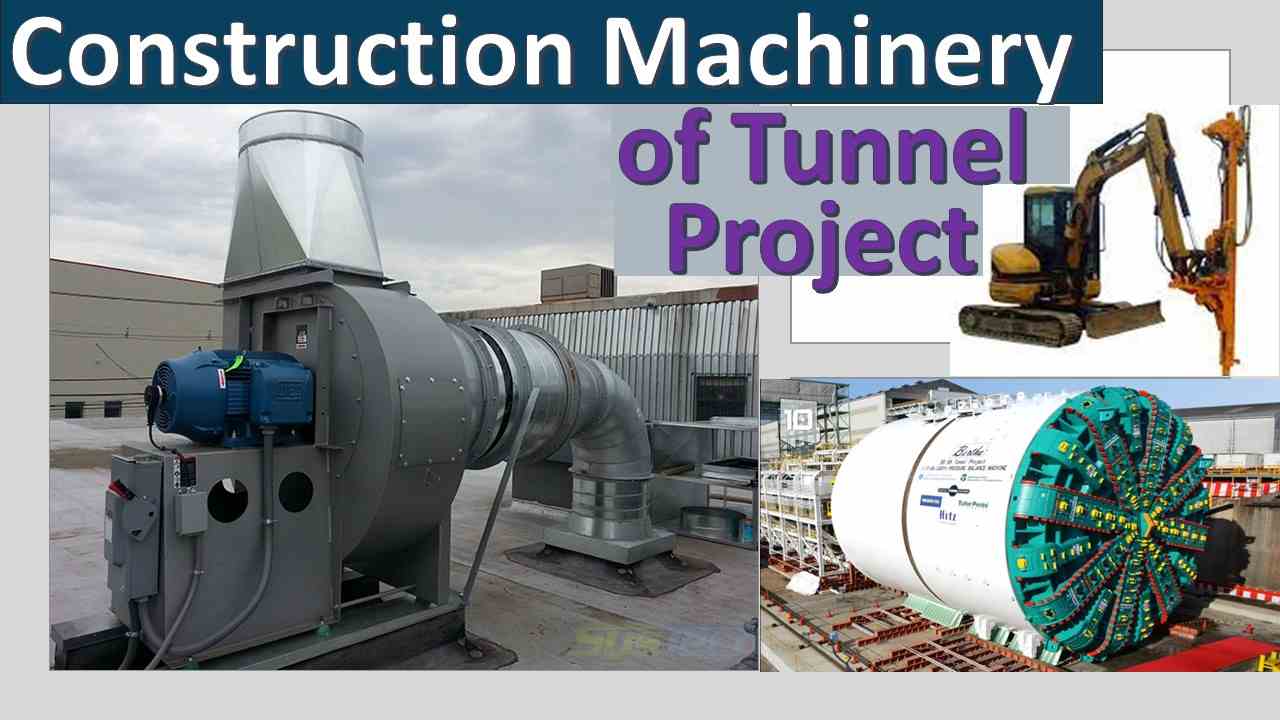Construction Machinery for Mega Tunnel Projects
- By
- Pooja |
- October 21, 2023 |
- Construction, Tunnel Engineering,

Table of Contents
Tunnel Boring Machines (TBMs):
Ventilation Systems and Equipment:
Concrete Mixing and Placing Equipment:
Surveying and Laser Technology:
Challenges and Solutions of Mega Tunnel Projects:
Mega tunnel projects represent awe-inspiring feats of engineering that traverse through mountains, beneath water bodies, and under urban landscapes. These ambitious endeavours demand a symphony of advanced construction techniques, innovative materials, and a fleet of specialized construction machinery. In this comprehensive guide, we will delve into the key types of construction machinery used in mega tunnel projects, exploring their functions, benefits, and the unique challenges they help overcome.
Tunnel Boring Machines (TBMs):
Tunnel Boring Machines are the workhorses of mega tunnel projects, carving through rock and soil with precision. These colossal machines consist of rotating cutter heads that excavate the material, while a conveyor system removes the debris. TBMs significantly reduce disturbance to the surrounding environment and minimize disruption to surface-level activities. They are essential for creating tunnels for transportation, utilities, and infrastructure.
Excavators and Rock Drills:
Excavators equipped with hydraulic rock drills are employed to break through hard rock formations encountered in tunnelling. They facilitate controlled rock fragmentation, allowing for easier excavation by subsequent machinery. These versatile machines contribute to efficient tunnel progress in challenging geological conditions.
Shotcrete Sprayers:
Shotcrete sprayers are used to apply a layer of concrete to the tunnel walls and ceilings, providing structural support and preventing rock instability. These machines ensure a uniform layer of shotcrete, enhancing the safety and stability of the tunnel during construction and throughout its operational life.
Tunnel Mucking Equipment:
Tunnel mucking equipment, such as tunnel loaders and conveyors, transports excavated material from the tunnel face to the surface. These machines play a crucial role in maintaining a smooth workflow by efficiently removing debris and preventing congestion within the tunnel.
Ventilation Systems and Equipment:
Mega tunnels require effective ventilation systems to maintain air quality, control temperature, and ensure worker safety. Ventilation equipment, including fans, ducting, and monitoring systems, provide a continuous flow of fresh air and remove contaminants from the tunnel environment.
Grouting Equipment:
Grouting is essential for stabilizing tunnel segments, reducing water ingress, and enhancing ground consolidation. Grouting equipment injects cementitious or chemical solutions into the rock and soil, creating a stable and impermeable tunnel lining.
Concrete Mixing and Placing Equipment:
Concrete is used for tunnel linings, shafts, and underground structures. Concrete mixing and placing equipment ensure the precise and efficient distribution of concrete within the tunnel. This machinery contributes to the structural integrity and durability of the tunnel infrastructure.
Shield Machines:
Shield machines, similar to TBMs, are used in soft ground conditions or areas with potential water ingress. They consist of a shield that supports the tunnel face and prevents collapse while the excavation takes place. Shield machines are essential for maintaining tunnel stability in challenging environments.
Surveying and Laser Technology:
Accurate surveying and alignment are critical for tunnel construction. Robotic total stations, laser scanners, and GPS equipment provide precise measurements and ensure proper alignment and dimensions of the tunnel structure.
Challenges and Solutions of Mega Tunnel Projects:
Geological Variability: Mega tunnel projects encounter diverse geological conditions, ranging from hard rock to soft soil. Adaptable machinery, such as TBMs with different cutter heads, ensures efficient excavation and lining installation in varying ground conditions.
Water Management: Tunnels crossing beneath water bodies require effective water management systems to prevent flooding during construction. Dewatering equipment, grouting techniques, and watertight tunnel lining contribute to maintaining a dry working environment.
Urban Congestion and Disruption: Tunneling in densely populated urban areas demands careful planning to minimize disruptions to surface-level activities. Advanced tunnelling techniques, proper machinery scheduling, and stakeholder engagement help mitigate congestion and disturbance.
Environmental Impact: Mega tunnel projects can impact ecosystems and air quality. Mitigation measures, low-emission machinery, and sustainable construction practices help reduce the environmental footprint of tunnel construction.
Safety in Confined Spaces: Working in confined tunnel spaces poses safety challenges for construction workers. Rigorous safety protocols, proper training, and continuous monitoring using technology contribute to a secure working environment.
Alignment and Precision: Accurate tunnel alignment and dimensions are crucial to ensure safe and efficient train or vehicular movement. Advanced surveying technology and precise machinery contribute to achieving alignment accuracy.
Budget and Cost Management: Effective budgeting and cost management are essential for tunnel projects. Optimizing machinery utilization, preventive maintenance, and efficient scheduling contribute to cost-effective construction.
In conclusion, construction machinery is the backbone of mega tunnel projects, enabling the creation of subterranean passageways that connect regions, improve transportation, and promote sustainable infrastructure. From TBMs and shotcrete sprayers to grouting equipment and ventilation systems, each type of machinery plays a vital role in excavating, stabilizing, and lining tunnels.
By addressing challenges through innovation, meticulous planning, and adherence to regulations, mega tunnel construction projects continue to redefine engineering possibilities, pushing the boundaries of what is achievable underground and contributing to the development of modern, efficient, and interconnected urban landscapes.

Pooja
Founder at gcelab.com, Pooja is an Entrepreneur unlocking human potential. Working in the Principles of Lean Start-up, Pooja believes in Transparency and User Happiness the most. Pooja’s background in teaching gives her a sophisticated grasp on even the most tedious aspect of course building. She is passionate about people who believe that good is not enough.
Previous Post
Effects of Tree Roots on Building
Next Post

